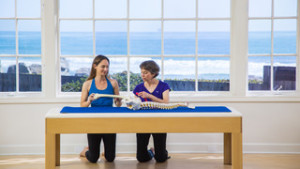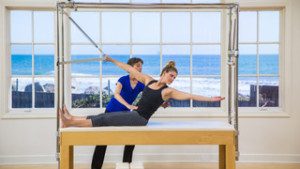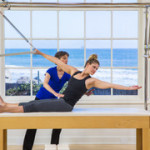Credit to Pilates Anytime
May 29, 2019
What I Know, What I Give, and What I Think
by Ruth Alpert
“You can only teach what you know,” my beloved teacher, colleague and friend Michele Larsson used to say.
What I know: How to work with bodies that have special needs, my own being one.
Michele taught me Pilates apprentice-style in 1992, before there were any official teacher training programs. We would meet for a private once a week, depending on the state of either of our body stories, and the rest of my time was spent observing Michele’s teaching and in my own practice. Michele trained me to be her backup; she was over-busy establishing and running The Institute for the Pilates Method. Her clients were mostly elderly and/or injured and/or dealing with an illness – in one way or another, not your average hardy athletic fitness client. My background was a perfect fit: I was already a certified practitioner of both The TRAGER® Approach and Klein Technique as well as a longtime student of Release Work (Lulu Sweigard), Body-Mind Centering (Bonnie Bainbridge Cohen), and Continuum (Emilie Conrad).
Building trust with clients in these states is paramount. Your client has to truly get that you won’t hurt them, as their previous treatment often has.
I make sure they know they are in control of the session and can veto anything I suggest they do. I tell them I will demonstrate first, and if they don’t like it, we can do something else … the Pilates studio is a playpen, with lots of “toys” and options.

There is only one rule: they cannot do anything that hurts. There will come a time for challenges later, but not now. We talk about the difference between “ooh, it hurts so good” and “is the lesson over yet, can I get out of here?” The acceptable one means absence of alarm. (This is a truism for me: challenge is good, pain is always inappropriate. When a body moves in alignment with its design, no part complains.)
It is a process of re-educating the nervous system that it is safe to move, by finding movement that is pleasurable.
It is also a process of empowering: one of the really hard issues with illness/injury/aging is being out of control of what is happening to one’s body. I take time in the lesson to explain; we look at anatomy pictures and skeleton models. Enlisting their thinking and intelligence is also part of constructing safety – with understanding comes control.
Another aspect of building trust is letting clients talk, tell their story. They have generally not been able to do that in the medical world and being listened to attentively goes a long way to building their connection with you.
What I give:
I often start with various breathing exercises. Hissing exhales (making the “S” sound – like in “Sam” – long and drawn out) are excellent to allow the diaphragm to fully release. Trauma is held in the diaphragm and ribs are often frozen in the inhale. Fully releasing the diaphragm in exhaling is often quite challenging – after all, no one runs away from a lion exhaling! I then alternate with a mild form of percussive breath pattern from the 100’s: up to 5 staccato sniffs in through nose, out through mouth. (Hint: long slow exhales will also help to stretch the psoas gently and passively).
I then introduce gentle movements (Eve Gentry Fundamentals mostly). I start with the pelvis/legs/feet for grounding and support. Heads and necks won’t release until someone is home down below. I find the big ball quite useful for leg sways with legs straight, knee folds bringing the ball in/out and then lateral sways with knees bent, hugging the ball close. Lateral rocking, which is easy to feel on the ball, is very useful … cradles are lateral rocking while sagittal rocking is about something else (now where’s a doctoral student looking for a good dissertation subject – I would love to see a study on this). Lateral rocking also subtly and effectively “wags the tail”, which further sends a signal to the nervous system that all is well. Of course, this series might not work with herniated lumbar discs, or might need to be quite small … always teach the person in front of you!

Other useful movements, depending on the body story: pelvic tilts/pelvic clock, ankle circles and bird feet (prehensile)/”Barbie” feet (the tip-toe position that the doll Barbie is in perpetually). Footwork on the reformer is very grounding and organizing – I think of it as a civilized form of kicking, which is a primal movement that most of us don’t get to do once we are past the temper tantrum age. Little curl backs on the spine corrector. “Pregnant Cat” to access the transversus along with crawling, if they can be on their hands and knees. For neck issues, very, very small nose circles can release tension. Elbow circles, side lying arm slides (half of “bow & arrow”). Too many to list here, but you get the idea.
I use the Goldilocks approach to spring weight: too heavy, too light, and just right. I let them feel all versions, if it’s safe to do so, and let them choose which they like the best.
What I think:
There is a difference between strength and stamina. Stamina fluctuates throughout your life. You get the flu, no stamina. You fall in love, plenty of stamina. Give up your attachment to stamina; it’s unreliable, especially with chronic and/or mystery illnesses. Precise organization is a path to strength. And healing is how fast you recover from setbacks, not that the setbacks don’t occur.
I allow for many lessons to lay a solid foundation of organizing the body. Once that is in place, progress to intermediate and higher levels can happen rapidly.
We all know our clients are our best teachers – even more so when dealing with special needs. Creativity, improvisation, and presence will serve you well!
 Ruth Alpert has an extensive background of professional training in New York City in classical ballet, beginning with George Balanchine’s School of American Ballet in 1960; modern dance, starting in 1956, including early training at Juilliard and eight
Ruth Alpert has an extensive background of professional training in New York City in classical ballet, beginning with George Balanchine’s School of American Ballet in 1960; modern dance, starting in 1956, including early training at Juilliard and eight
years of Merce Cunningham technique. Ruth graduated from Bard College with a BA in dance in 1973 and has done graduate work at the California Institute of the Arts. She was certified as a practitioner of The Trager ® Approach in 1987, certified in Pilates in 1993, certified in GYROTONIC® Method in 2002, and graduated as an Alexander Technique teacher in 2007.
Ruth has performed with modern and post-modern choreographers. She was an original member of Douglas Dunn & Dancers Company in New York City and while in Austin was a guest with the Deborah Hay Dance Company. Ruth has been Appalachian flatfoot dancing for 42 years. She has taught workshops, danced with Old-Timey string bands, busked (street performed) in various cities in at least 6 states. She currently does foot percussion as a member of The Honeysuckle Possums, a local Santa Barbara all female Americana band.
In 1977, Ruth began to look for a solution to the chronic pain and injury that seemed to be part of a dancer’s life. She began to work with Susan Klein, and studied Release Work (Lulu Sweigard lineage) and the work of Bonnie Bainbridge Cohen of The School for Body-Mind Centering. She was a student of Emilie Conrad’s “Continuum” work for over 8 years. Ruth was trained in pilates by Michele Larsson in 1992, and has been an Associate of Core Dynamics Pilates Teacher Training since 1998.
www.RuthAlpert.com


 Ruth Alpert has an extensive background of professional training in New York City in classical ballet, beginning with George Balanchine’s School of American Ballet in 1960; modern dance, starting in 1956, including early training at Juilliard and eight
Ruth Alpert has an extensive background of professional training in New York City in classical ballet, beginning with George Balanchine’s School of American Ballet in 1960; modern dance, starting in 1956, including early training at Juilliard and eight
